Introduction
Natural gas is a versatile and abundant fossil fuel that has gained popularity as a vehicle fuel in recent years. With its lower emissions and cost-effective nature, natural gas is considered a viable alternative to conventional fuels for powering cars. In this article, we will explore the basic information about natural gas as a vehicle fuel, the reasons behind its use, and the comparison between natural gas and conventional fuels.
What is Natural Gas?
Natural gas is a hydrocarbon gas mixture primarily composed of methane (CH4) along with other trace gases. It is formed from the decomposition of organic matter over millions of years. Natural gas is found in underground reservoirs and can be extracted through drilling and processing techniques.
As a vehicle fuel, natural gas can be used in compressed natural gas (CNG) or liquefied natural gas (LNG) form. CNG is obtained by compressing natural gas to a pressure of approximately 3,000 to 3,600 pounds per square inch (psi), while LNG is obtained by cooling natural gas to a temperature of around -260°F, converting it into a liquid state for easier storage and transportation.
Why Use Natural Gas as a Vehicle Fuel?
There are several reasons why natural gas is being increasingly used as a vehicle fuel:
- Environmental Benefits: Natural gas produces fewer greenhouse gas emissions compared to conventional fuels, resulting in lower carbon dioxide (CO2), nitrogen oxide (NOx), and particulate matter emissions. It helps in reducing air pollution and mitigating climate change.
- Cost-Effectiveness: Natural gas is generally cheaper than gasoline or diesel, providing cost savings to vehicle owners. Additionally, the price of natural gas is relatively stable compared to the volatile prices of conventional fuels.
- Abundance and Domestic Availability: Natural gas reserves are abundant, especially in countries like the United States, Russia, and Iran. This domestic availability reduces dependence on foreign oil and enhances energy security.
- Infrastructure Development: The infrastructure for natural gas refueling stations is expanding, making it more convenient for vehicle owners to access and use natural gas as a fuel.
Natural Gas vs. Conventional Fuels
In comparison to conventional fuels, natural gas offers several advantages:
| Aspect | Natural Gas | Conventional Fuels |
|---|---|---|
| Emissions | Lower greenhouse gas emissions | Higher greenhouse gas emissions |
| Cost | Generally cheaper | Varies with oil prices |
| Availability | Abundant and domestically available | Dependent on imports |
| Infrastructure | Expanding refueling station network | Well-established infrastructure |
By understanding the basic information about natural gas as a vehicle fuel, its advantages, and the comparison with conventional fuels, we can better assess its potential as a sustainable and efficient alternative for powering cars.

Benefits of Natural Gas as a Vehicle Fuel
Environmental Benefits
Natural gas is known for its lower carbon emissions compared to traditional fossil fuels. When used as a vehicle fuel, natural gas produces fewer greenhouse gas emissions, contributing to reduced air pollution and improved air quality. It also emits significantly lower levels of harmful pollutants such as nitrogen oxides, particulate matter, and sulfur oxides, making it a cleaner alternative for transportation.
Cost Savings
One of the major advantages of natural gas as a vehicle fuel is its cost-effectiveness. Natural gas prices are generally lower than gasoline or diesel, resulting in significant savings for vehicle owners. In addition, natural gas vehicles typically have higher fuel efficiency, allowing drivers to travel more miles per gallon equivalent (MPGe) and further reducing fuel costs.
Domestic Energy Source
Using natural gas as a vehicle fuel promotes energy security and reduces reliance on imported oil. Natural gas is abundantly available domestically, making it a more reliable and sustainable energy source. By utilizing this domestic resource, countries can reduce their dependence on foreign oil and strengthen their energy independence.
Reduced Dependence on Oil
Natural gas vehicles provide an opportunity to diversify the transportation fuel mix and reduce dependence on oil. With fluctuating oil prices and concerns about oil supply disruptions, transitioning to natural gas as a vehicle fuel can help mitigate these risks. By using natural gas instead of oil, countries can reduce their vulnerability to oil price volatility and geopolitical tensions.
Infrastructure Availability
Another advantage of natural gas as a vehicle fuel is the existing infrastructure. Many countries already have a well-established natural gas distribution network, making it easier to build refueling stations and support the growth of natural gas vehicles. This infrastructure availability ensures that natural gas is a viable option for vehicle owners, providing convenience and accessibility in fueling their vehicles.

Natural Gas Vehicles (NGVs)
Types of NGVs
Natural Gas Vehicles (NGVs) are vehicles that use natural gas as their primary fuel source. There are two main types of NGVs:
- Bi-Fuel NGVs: These vehicles have the capability to run on either natural gas or gasoline. They have two separate fueling systems, allowing drivers to switch between fuels as needed.
- Dedicated NGVs: These vehicles are designed to run solely on natural gas. They have a single fueling system that is optimized for natural gas usage.
Engine Conversion Kits
For those who already own a gasoline-powered vehicle and want to switch to natural gas, engine conversion kits are available. These kits allow the existing engine to be modified to run on natural gas. The conversion process involves installing a natural gas storage system and making adjustments to the engine’s fuel injection system.
OEM NGVs
Original Equipment Manufacturer (OEM) NGVs are vehicles that are manufactured to run on natural gas from the factory. These vehicles are specifically designed and built to optimize the use of natural gas as a fuel source. OEM NGVs often have higher efficiency and performance compared to converted vehicles.
Refueling Options
NGVs can be refueled at specialized natural gas stations. These stations provide compressed natural gas (CNG) or liquefied natural gas (LNG) to fill up NGVs. CNG stations are more common and can be found in many locations, while LNG stations are less common and mainly used for long-haul trucking. Some NGVs also have the capability to refuel at home using a natural gas compressor.
Range and Performance
NGVs have a comparable range to gasoline-powered vehicles, with bi-fuel NGVs having a slightly shorter range when running on natural gas. The performance of NGVs is also similar to gasoline-powered vehicles, with comparable acceleration and top speeds. However, dedicated NGVs may have slightly reduced power output compared to their gasoline counterparts.
It is important to note that the availability of natural gas refueling infrastructure may vary depending on the location, which can affect the practicality of owning an NGV.

Natural Gas Fueling Infrastructure
As the demand for cleaner and more sustainable transportation options grows, natural gas has emerged as a viable alternative to traditional gasoline and diesel fuels. Natural gas can be used to power vehicles through the combustion of compressed natural gas (CNG) or liquefied natural gas (LNG). Additionally, biogas and renewable natural gas (RNG) offer renewable and low-carbon alternatives to conventional natural gas. To support the widespread adoption of natural gas vehicles, a robust fueling infrastructure is essential.
Compressed Natural Gas (CNG) Stations
CNG stations are designed to compress natural gas to a pressure suitable for vehicle refueling. These stations typically consist of a compressor, storage tanks, and dispensers. The compression process reduces the volume of natural gas, allowing for more efficient storage and transportation. CNG stations can be found at various locations, including public fueling stations, private fleet depots, and even some residences. The availability and accessibility of CNG stations are crucial for the successful deployment of natural gas vehicles.
Liquefied Natural Gas (LNG) Stations
LNG stations are equipped to liquefy natural gas, enabling its use as a vehicle fuel. The liquefaction process cools the gas to approximately -162 degrees Celsius, reducing its volume and making it easier to transport and store. LNG stations typically consist of storage tanks, vaporizers, and dispensers. These stations are commonly found along major transportation routes and in areas with a high demand for LNG, such as ports and industrial hubs. LNG stations play a vital role in facilitating long-haul transportation using natural gas as a fuel.
Biogas and Renewable Natural Gas (RNG) Stations
Biogas and RNG stations offer renewable and low-carbon alternatives to conventional natural gas. Biogas is produced through the anaerobic digestion of organic waste, while RNG is derived from renewable sources such as landfills, wastewater treatment plants, and agricultural waste. These stations typically utilize purification processes to remove impurities and ensure the quality of the gas. Biogas and RNG stations are strategically located near the sources of renewable gas production, providing a sustainable fueling option for natural gas vehicles.
In addition to CNG, LNG, and biogas/RNG stations, there are also hybrid stations that offer multiple fueling options to cater to a wide range of natural gas vehicles. These hybrid stations provide both CNG and LNG dispensers, allowing vehicles to choose the most suitable fueling method based on their needs.
The development of a comprehensive and accessible natural gas fueling infrastructure is crucial to encourage the adoption of natural gas vehicles. Governments, energy companies, and transportation stakeholders must work together to invest in the expansion of CNG, LNG, and biogas/RNG stations, ensuring that drivers have convenient access to this environmentally friendly fueling option.

Challenges and Considerations
While natural gas is an attractive alternative fuel option for powering cars, there are several challenges and considerations that need to be addressed before widespread adoption can occur.
1. Limited Fueling Infrastructure
One of the major hurdles to the widespread use of natural gas as a vehicle fuel is the limited availability of fueling infrastructure. Unlike gasoline stations that are ubiquitous, natural gas fueling stations are still relatively scarce. This can make it inconvenient for drivers to find a nearby station to refuel their vehicles, especially in rural areas. To address this challenge, there needs to be a significant investment in building more natural gas fueling stations across the country.
2. Vehicle Range and Refueling Time
Compared to gasoline-powered vehicles, natural gas vehicles (NGVs) typically have a shorter range. This is because natural gas has a lower energy density compared to gasoline. As a result, NGVs may require more frequent refueling, which can be inconvenient for drivers on long trips. Additionally, the refueling process for natural gas vehicles takes longer compared to gasoline refueling, as the gas needs to be compressed into the vehicle’s storage tanks. Improving vehicle range and reducing refueling time are crucial considerations for making natural gas a viable option for everyday use.
3. Upfront Costs
The upfront costs of purchasing a natural gas vehicle can be higher compared to traditional gasoline-powered vehicles. This is primarily due to the additional technology and infrastructure required to store and deliver natural gas to the engine. While there are potential long-term cost savings from using natural gas as a fuel, the higher initial investment may deter some consumers from choosing NGVs. Lowering the upfront costs and providing incentives for purchasing natural gas vehicles can help overcome this challenge.
4. Safety Concerns
There are safety concerns associated with the use of natural gas as a vehicle fuel. Natural gas is highly flammable, and there is a risk of leaks or explosions in case of accidents or improper handling. Proper training and safety protocols need to be in place for both drivers and fueling station operators to minimize these risks. Additionally, the storage and transportation of natural gas require specialized equipment and infrastructure to ensure safe handling. Addressing these safety concerns is crucial for gaining public trust and confidence in the use of natural gas as a vehicle fuel.
In conclusion, while natural gas has the potential to power cars and reduce greenhouse gas emissions, there are several challenges and considerations that need to be addressed. These include the limited fueling infrastructure, vehicle range and refueling time, upfront costs, and safety concerns. By overcoming these challenges, natural gas can become a viable and sustainable alternative to traditional gasoline-powered vehicles.

Government Support and Incentives
As the world shifts towards cleaner and more sustainable transportation options, governments at the federal, state, and local levels are implementing various support programs and incentives to promote the adoption of natural gas as a fuel for cars. These initiatives aim to reduce greenhouse gas emissions, improve air quality, and decrease dependence on fossil fuels.
Federal Incentives
The federal government offers several incentives to encourage the use of natural gas vehicles (NGVs) and infrastructure development:
- Alternative Fuel Vehicle Refueling Property Tax Credit: Individuals and businesses can claim a tax credit of up to 30% of the cost of installing a natural gas refueling station.
- Alternative Fuel Excise Tax Credit: NGV owners can receive a tax credit for the use of natural gas as a transportation fuel, which is calculated based on the energy content of the fuel.
- Alternative Fuel Infrastructure Tax Credit: Businesses can claim a tax credit of up to 30% of the cost of constructing or retrofitting natural gas refueling stations.
State and Local Incentives
In addition to federal incentives, many states and local governments offer their own support programs to encourage the adoption of natural gas as a transportation fuel. These incentives vary by location but can include:
- Tax credits or exemptions for NGV purchases or conversions.
- Grants or loans for the construction of natural gas refueling infrastructure.
- Discounted registration fees or tolls for NGVs.
- High-occupancy vehicle (HOV) lane access for NGVs, even with a single occupant.
Tax Credits and Grants
Various tax credits and grants are available to individuals, businesses, and fleet operators to support the adoption of natural gas as a transportation fuel:
- Vehicle Purchase Tax Credits: Individuals purchasing new NGVs may be eligible for tax credits, which vary by the vehicle’s fuel efficiency and emission levels.
- Conversion Grants: Financial assistance is available for converting conventional vehicles to run on natural gas.
- Infrastructure Grants: Grants are provided to support the construction or expansion of natural gas refueling stations.
- Research and Development Grants: Funding opportunities are available for research and development projects focused on advancing natural gas vehicle technologies and infrastructure.
It’s important to note that the availability and specifics of these incentives can vary by location and are subject to change. Therefore, it is recommended to check with local government agencies or consult online resources for the most up-to-date information on government support and incentives for natural gas vehicles.
Conclusion
In conclusion, natural gas has emerged as a promising alternative to power cars due to its numerous benefits. It is a cleaner and more environmentally friendly fuel compared to traditional gasoline or diesel. Natural gas vehicles produce lower emissions of greenhouse gases and pollutants, contributing to improved air quality and reduced carbon footprint.
Moreover, natural gas is abundant and widely available, making it a cost-effective option for vehicle owners. With the increasing infrastructure for natural gas refueling stations, the accessibility of this fuel is gradually expanding, allowing more drivers to consider natural gas vehicles as a viable choice.
While there are certain challenges associated with the adoption of natural gas as a fuel for cars, such as limited refueling infrastructure and higher upfront costs for vehicles, the long-term benefits outweigh the initial drawbacks. The potential for reducing dependence on imported oil, mitigating climate change, and improving local air quality makes natural gas an attractive option for the transportation sector.
Future Outlook
The future of natural gas as a fuel for cars looks promising. Many countries and regions are actively promoting the use of natural gas vehicles as part of their efforts to transition to more sustainable transportation systems. Governments are offering incentives and subsidies to encourage the adoption of natural gas vehicles, and automotive manufacturers are developing advanced technologies to improve the efficiency and performance of these vehicles.
In addition, the development of renewable natural gas and the integration of natural gas with other sustainable energy sources, such as hydrogen, are further enhancing the potential of natural gas as a fuel for cars. These advancements will address concerns about the limited availability of fossil fuel-based natural gas and contribute to a more sustainable and diversified energy mix for transportation.
Final Thoughts
As the world seeks cleaner and more sustainable alternatives to power cars, natural gas has emerged as a viable option. Its environmental benefits, cost-effectiveness, and potential for reducing dependence on imported oil make it an attractive choice for vehicle owners and governments alike. With ongoing advancements in technology and infrastructure, natural gas is expected to play a significant role in the future of transportation.
